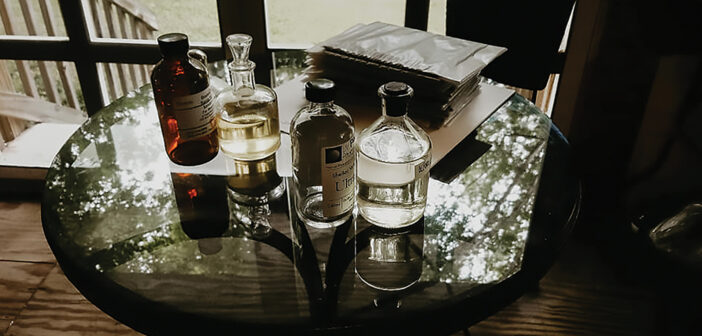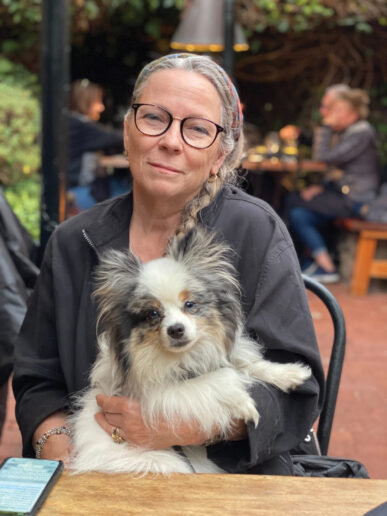
Zeiss and Flash, her rescue dog
In the very beginning, Rebecca Zeiss tried her best NOT to be a photographer. Because of her last name (the Zeiss company has been a worldwide leader in photographic lenses since 1890), she wanted to make a personal impact with a different style or artform. She studied painting and drawing at the University of Michigan in Ann Arbor and took a photography class solely as a way to document and showcase her creations. That class, however, led to photography as a hobby and eventually a profession. In the end, she couldn’t escape it.
“I took the class for fun,” she remembers. “I wanted to photograph my work and thought it would be a good way to document my portfolio. It wasn’t meant to be my focus.” To make ends meet, she worked as a wedding photographer but realized that kind of work wasn’t for her. “Doing that made me hate my camera and I quit taking pictures for nearly five years. I didn’t pick up my camera again until 2002,” she adds. It was then that she found inspiration and a way to blend the medium with her understanding of art and the world. She received her MFA in photography from Central Michigan University and since 2005, has taught photography and printmaking at UM-Flint. Her work has been exhibited in private collections, museums and universities throughout the United States and internationally.
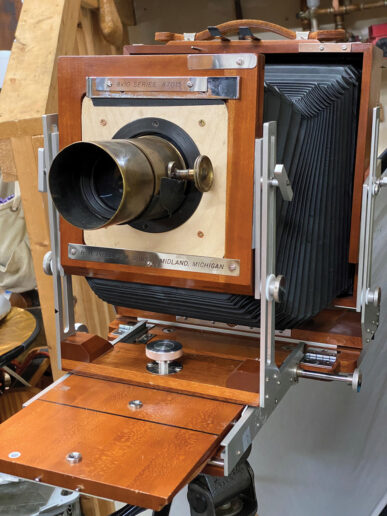
Inspired by shared individual stories, memories and dreams, her photography and subsequent collections are centered on objects and their storytellers. For example, “Aura Objecta” is a collection of images of her grandfather’s tools as they appear used and weathered from years of use, or appearing as well-cared-for and gleaming. Each tool holds profound energy and aura reflected in the life of her grandfather. In “Forgiveness,” Zeiss uses her own objects to portray her experience in a confining relationship, and “Glimpses of Invented Dreams” captures objects that represent a participants’ shared dreams. The range of her works are printed on Japanese Kozo paper or developed with the collodion plate process.
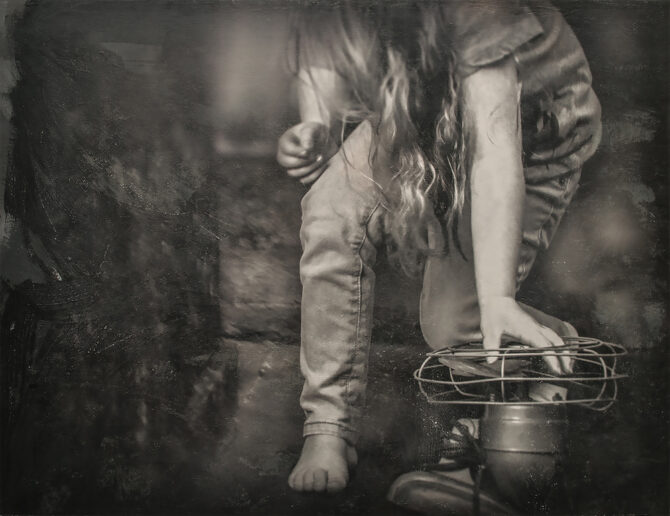
“I listen to their stories while we go through the process of recording and creating their image.”
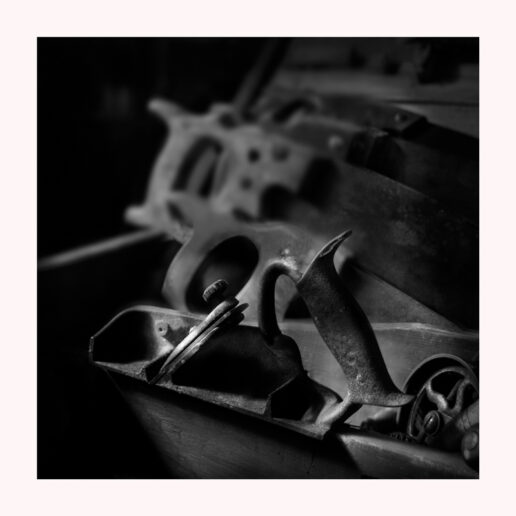
A piece from the “Aura Objecta” collection
Her most recent installation entitled “Seeking Solace” was exhibited through the month of December at Flint’s Buckham Gallery. In it, each picture acts as a doorway to a story – an image representing the hopes, dreams, loves and tragedies of each individual participant through the history of a chosen object. “Each subject is a volunteer who brought an item with them that holds an important story in their life,” explains Zeiss. “I listen to their stories while we go through the process of recording and creating their image.” It is in this way that Zeiss portrays the memories and impact of the time shared by all of us. In each black & white photo, an anonymous participant presents a personal object in a way that reflects their feelings toward the object.
Truly, her photography process itself is an art form. Zeiss uses a R.H. Phillips & Sons 8×10 large format camera equipped with a Petzval lens (the first portrait objective lens in the history of photography, developed in 1840) and an antiquated wet plate collodion process developed in 1851. She has worked on this project for seven years and only during the spring and summer months, as natural UV light is needed. To date, she has pictures of 50 subjects and their stories. Her long-term goal is to publish the images and their stories in a book. “I don’t really have a set number of subjects to record stories of,” she says. “I’ll know when to end it when the time comes. For now, I’m just getting ready for my next participants.”
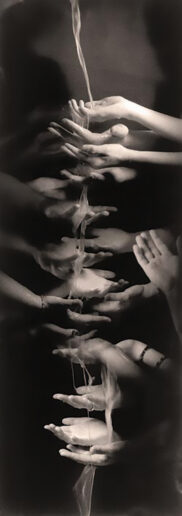 The process of “Seeking Solace” is shared between Zeiss and her participants from beginning to end. (The walk-through provided here is just a rudimentary description of it, as many chemicals and agents must be applied in sequence and each step must be completed in a very precise manner for a successful outcome.) To begin, the participant holds their selected item and sits patiently while the focus and design are set. Next, the two prepare the plate in the dark room, then back to the camera for capture. “Depending upon a number of factors, they will sit between two seconds to two minutes on average,” adds Zeiss. Then, the plate is taken to the dark room and developed. Once the image is approved, the original is scanned and printed to photo paper, then coated with resin to create the best reproduction of the original plate. The image capture process can take an hour to three hours on average, during which time the participant shares their story with Zeiss.
The process of “Seeking Solace” is shared between Zeiss and her participants from beginning to end. (The walk-through provided here is just a rudimentary description of it, as many chemicals and agents must be applied in sequence and each step must be completed in a very precise manner for a successful outcome.) To begin, the participant holds their selected item and sits patiently while the focus and design are set. Next, the two prepare the plate in the dark room, then back to the camera for capture. “Depending upon a number of factors, they will sit between two seconds to two minutes on average,” adds Zeiss. Then, the plate is taken to the dark room and developed. Once the image is approved, the original is scanned and printed to photo paper, then coated with resin to create the best reproduction of the original plate. The image capture process can take an hour to three hours on average, during which time the participant shares their story with Zeiss.
Although the parameters of the process are the same for all the images in this body of work, each is a unique representation of the storyteller expressed within a common theme as seen or not seen through the lens’ focus and depth. “One lesson I want my students to learn is to remember design. Pay attention to the focal point of the photo and avoid what I call “thing in the middle” syndrome,” Zeiss laughs. Zeiss will often have her students visit her home in Midland for lessons and to take part in her antiquated processes.
Through “Seeking Solace” and other past inspirations, Zeiss continues to create art through photography that reflects humanity’s collective unconscious and energy. Her photographs hold an air of both mystery and understanding as the viewer uncovers their own personal meaning. And, the beauty of it all is the realization that there is more to come.
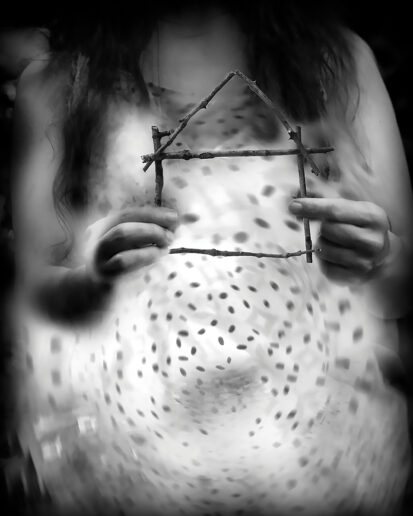
One of Zeiss’ favorite photos from “Seeking Solace.” in the subject’s story, the house represents anxiety about what will happen to us, our lives and security as the world moves forward
“I am still looking for people to join the “Seeking Solace” project,” she says. “It will continue until it’s no longer challenging. Everyone has a story to tell.”
If you are interested in participating in Rebecca’s project, email Zeissphoto@yahoo.com. To view examples of her work, visit Zeissworks.com.
Photos provided by Rebecca Zeiss

